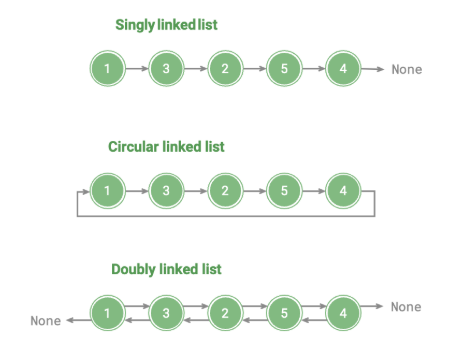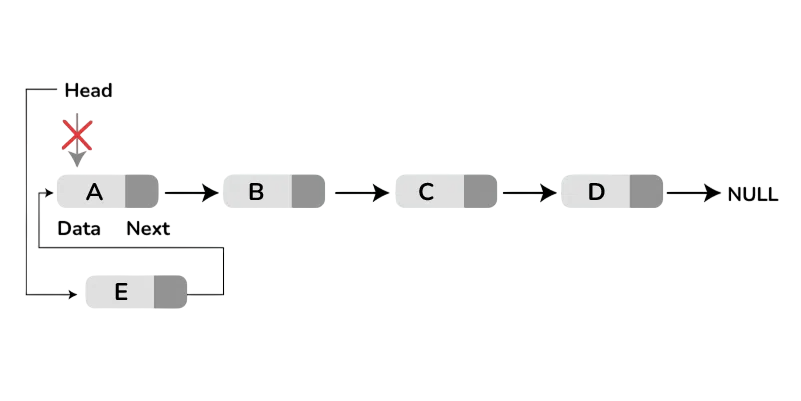
- Introduction to Linked Lists
- Why Use Linked Lists Over Arrays?
- Types of Linked Lists (Singly, Doubly, Circular)
- Structure of a Node in a Linked List
- Creating a Linked List in C/C++/Java/Python
- Insertion Operations (Beginning, End, Middle)
- Deletion Operations (By Position, By Value)
- Traversal and Display of Linked List Elements
- Conclusion
Introduction to Linked Lists
A Linked List in Data Structure is a fundamental linear data structure used to store a sequence of elements. Unlike arrays, linked lists store elements as a series of nodes, each containing the data and a reference (or pointer) to the next node in the sequence. This structure allows for dynamic memory allocation, making linked lists ideal for situations where the size of the data structure is unpredictable or frequently changes during execution. Linked lists form the basis for more complex structures like stacks, queues, and graphs, and are extensively used in memory management and operating systems.A linked list is a fundamental data structure used in computer science to organize and store data efficiently. Unlike arrays, Web Designing & Development Training which store elements in contiguous memory locations, linked lists consist of nodes where each node contains data and a reference (or pointer) to the next node in the sequence. This structure allows for dynamic memory allocation, making linked lists highly flexible when it comes to inserting or deleting elements. There are several types of linked lists, including singly linked lists, where each node points to the next node; doubly linked lists, where nodes have pointers to both the next and previous nodes; and circular linked lists, where the last node links back to the first node, forming a loop. Linked lists are widely used in applications that require efficient insertion and deletion of elements, such as implementing stacks, queues, and adjacency lists for graphs. They avoid the limitations of fixed-size arrays and reduce the need for resizing or shifting elements. However, linked lists do not allow random access like arrays, so traversing them to reach a specific element takes linear time. Understanding linked lists is essential for grasping more complex data structures and algorithms, as they form the building blocks for many advanced programming concepts.
To Earn Your Web Developer Certification, Gain Insights From Leading Data Science Experts And Advance Your Career With ACTE’s Web Developer Courses Today!
Why Use Linked Lists Over Arrays?
While arrays offer fast indexing and are easy to use, they have several limitations that linked lists overcome:
- Dynamic Size: Arrays are of fixed size, requiring reallocation if they exceed capacity. Reverse a String Linked lists grow and shrink dynamically.
- Efficient Insertions/Deletions: In arrays, inserting or deleting elements in the middle requires shifting elements, which is inefficient. Linked lists allow these operations with simple pointer updates.
- Memory Usage: Arrays may allocate unused memory, while linked lists allocate memory as needed.
- No Need for Contiguous Memory: Arrays require contiguous memory blocks, whereas linked lists use scattered memory locations, which can help avoid fragmentation.
However, arrays offer constant-time access to elements via indices, while linked lists require traversal, making them slower for random access operations.
Types of Linked Lists (Singly, Doubly, Circular)
Types of Linked Lists come in several variations based on how the nodes are linked:
- Singly Linked List (SLL): Each node contains data and a pointer to the next node. The last node points to NULL.
- Doubly Linked List (DLL): Each node has three fields: data, a pointer to the next node, and a pointer to the previous node Lambda Expression . This allows bidirectional traversal.
- Circular Linked List: The last node’s next pointer points back to the head (first node), forming a circle. This can be singly or doubly circular.

Each type has its advantages. For example, doubly linked lists make deletion easier, while circular lists are useful for applications requiring continuous iteration.
Would You Like to Know More About Web Developer? Sign Up For Our Web Developer Courses Now!
Structure of a Node in a Linked List
The node is the building block of a linked list Web Designing & Development Training. A node typically consists of two components:
- Data: The actual information stored (e.g., integer, string, object).
- Pointer/Reference: A link to the next node (and previous, in the case of doubly linked lists).
In C/C++:
- struct Node {
- int data;
- Node* next;
- };
In Java:
- class Node {
- int data;
- Node next;
- }
In Python:
- class Node:
- def __init__(self, data):
- self.data = data
- self.next = None
This structure enables the dynamic nature of linked lists, as each node links to the next, forming a chain.
Creating a Linked List in C/C++/Java/Python
To create a linked list, you instantiate the nodes and connect them using pointers or references Prim’s Algorithm Explanation.
Example in Python:
- class Node:
- def __init__(self, data):
- self.data = data
- self.next = None
- head = Node(10)
- second = Node(20)
- third = Node(30)
- head.next = second
- second.next = third
In this simple list, the head points to second, which points to third. The third node’s next is None, indicating the end of the list.
Are You Interested in Learning More About Web Developer? Sign Up For Our Web Developer Courses Today!
Insertion Operations (Beginning, End, Middle)
Linked lists support multiple insertion operations:
- At the Beginning: Insert the new node and point it to the current head, then update the head.
- new_node.next = head
- head = new_node
- At the End: Traverse to the end and set the last node’s next to the new node Fibonacci Series in Python .
- At a Specific Position (Middle): Traverse to the node before the desired position and update pointers accordingly.
- temp = head
- for i in range(position – 1):
- temp = temp.next
- new_node.next = temp.next
- temp.next = new_node
- By Position: Traverse to the node before the target, and change its next pointer to skip the target node.
- By Value: Search for the node containing the desired value and unlink it from the list Kruskal Algorithm in DAA.
- temp = head
- while temp.next.data != value:
- temp = temp.next
- temp.next = temp.next.next
- temp = head
- while temp is not None:
- print(temp.data)
- temp = temp.next

These operations vary in time complexity but offer flexibility unmatched by arrays.
Deletion Operations (By Position, By Value)
Deletion Operations elements from a linked list involves updating pointers to remove the target node:
Example:
In doubly linked lists, deletion is more efficient since nodes have backward pointers as well.
Traversal and Display of Linked List Elements
To display the elements of a linked list, you traverse from the head node to the end:
This traversal takes O(n) time, Kruskal Algorithm in DAA where n is the number of nodes. In doubly linked lists, backward traversal is also possible by starting from the tail and using the prev pointers.
Conclusion
Linked lists are a dynamic, pointer-based linear data structure that provide efficient insertions and deletions compared to arrays. Various types, such as singly, doubly, and circular, cater to different use cases. While they don’t support fast random access, their flexibility makes them invaluable for memory-efficient and dynamic programming scenarios Web Designing & Development Training . Mastery of linked list concepts is crucial for data structure fundamentals, interview preparation, Linked List in Data Structure and software design.





